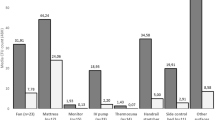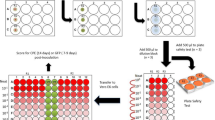Abstract
Sporothrix brasiliensis is recognized as an emergent fungal pathogen and the high amount of fungal propagules in the lesions of infected cats allows the contamination of surfaces by direct contact. Given that the environment can play a role in the transmission of this fungus, effective methods to eliminate this pathogen from contaminated surfaces are necessary. Physical methods, such as ultraviolet light C (UVC), are broad used for surfaces disinfection, however, non-data about its activity against S. brasiliensis is reported. Therefore, we aimed to evaluate an easy handled prototype of a UVC device, in the inhibition of S. brasiliensis. Three doses and times of exposure of irradiance were tested: 3.5 mJ/cm2 (1 s), 5.25 mJ/cm2 (1.5 s) and 329 mJ/cm2 (94 s) against a standardized inoculum of yeast and mold phase of S. brasiliensis. A decrease in CFU was shown in all doses of irradiance in both phases of S. brasiliensis, the average reduction ranged from 78 to 100% among doses, being a complete fungicidal activity achieved against the yeast phase after the 94 s exposure (329 mJ/cm2). Our data shows that UVC is a potential physical method for disinfection of surfaces contaminated with S. brasiliensis, and the prototype device developed provides an easy handling, and quickly results.


Similar content being viewed by others
Data availability
Not applicable.
References
Barros MBL, Schubach AO, do Valle ACF et al (2004) Cat-transmitted sporotrichosis epidemic in Rio de Janeiro, Brazil: description of a series of cases. Clin Infect Dis 38:529–535. https://doi.org/10.1086/381200
Poester VR, Stevens DA, Basso RP, Munhoz LS, Zanchi M, Benelli JL, Klafke GB, Cardone S, Xavier MO (2022) CATastrophe: Response to the challenges of zoonotic sporotrichosis in southern Brazil. Mycoses 65(1):30–34. https://doi.org/10.1111/myc.13363
Rabello VBS, Almeida MA, Bernardes-Engemann AR, Almeida-Paes R, de Macedo PM, Zancopé-Oliveira RM (2022) The Historical Burden of Sporotrichosis in Brazil: a Systematic Review of Cases Reported from 1907 to 2020. Braz J Microbiol 53(1):231–244. https://doi.org/10.1007/s42770-021-00658-1
Gremião IDF, da Rocha EMS, Montenegro H et al (2021) Guideline for the management of feline sporotrichosis caused by Sporothrix brasiliensis and literature revision. Braz J Microbiol 52:107–124. https://doi.org/10.1007/s42770-020-00365-3
Oliveira MME, Almeida-Paes R, Muniz MM, Gutierrez-Galhardo MC, Zancope-Oliveira RM (2011) Phenotypic and molecular Sporothrix identification of isolates from an epidemic area of sporotrichosis in Brazil. Mycopathologia 172:257–267. https://doi.org/10.1007/s11046-011-9437-3
Rodrigues AM, Teixeira MM, Hoog GS, Schubach TMP, Pereira SA, Fernandes GF, Bezerra LML, Felipe MS, Camargo ZP, Santos PO (2013) Phylogenetic analysis reveals a high prevalence of Sporothrix brasiliensis in feline sporotrichosis outbreaks. PLoS Negl Trop Dis 7:e2281. https://doi.org/10.1371/journal.pntd.0002281
Montenegro H, Rodrigues AM, Dias MAG, Silva EA, Bernardi F, Camargo ZP (2014) Feline sporotrichosis due to Sporothrix brasiliensis: an emerging animal infection in São Paulo, Brazil. BMC Vet Res 10(1). https://doi.org/10.1186/s12917-014-0269-5
Boechat JS, Oliveira MME, Almeida-Paes R, Gremião IDF, Machado ACS, Oliveira RVC, Figueiredo ABF, Rabello VBS, Silva KBL, Zancopé-Oliveira RM, Schubach TMP, Pereira AS (2018) Feline sporotrichosis: associations between clinical-epidemiological profiles and phenotypic-genotypic characteristics of the etiological agents in the Rio de Janeiro epizootic area. Mem Inst Oswaldo Cruz 113:185–196. https://doi.org/10.1590/0074-02760170407
Poester VR, Mattei AS, Madrid IM, Pereira JTB, Klafke GB, Sanchotene KO, Brandolt TM, Xavier MO (2018) Sporotrichosis in Southern Brazil, towards an epidemic? Zoonoses Public Health 65:815–821. https://doi.org/10.1111/zph.12504
Rossow JA, Queiroz-Telles F, Caceres DH et al (2020) A One Health Approach to Combatting Sporothrix brasiliensis Narrative review of an Emerging Zoonotic Fungal Pathogen in South America. J Fungi (Basel) 6(4):247. https://doi.org/10.3390/jof6040247
World Health Organization (WHO), Food and Agriculture Organization of the United Nations (FAO), World Organization for Animal Health (OIE) (2019) Taking a multisectoral, one health approach. In: A Tripartite Guide to Addressing Zoonotic. Diseases in Countries https://apps.who.int/iris/bitstream/handle/10665/325620/9789241514934-eng.pdf?sequence=1&isAllowed=y. Accessed 22 August 2023
Almeida-Silva F, Rabello VBdS, Scramignon-Costa BdS, Zancopé-Oliveira RM, de Macedo PM, Almeida-Paes R (2022) Beyond Domestic Cats: Environmental Detection of Sporothrix brasiliensis DNA in a Hyperendemic Area of Sporotrichosis in Rio de Janeiro State, Brazil. J Fungi 8(6):604. https://doi.org/10.3390/jof8060604
Madrid IM, Mattei AS, Santin R, Gomes AR, Cleff MB, Meireles MCA (2012) Inhibitory effect of sodium hypochlorite and chlorhexidine digluconate in clinical isolates of Sporothrix schenckii. Mycoses 55:281–285. https://doi.org/10.1111/j.1439-0507.2011.02101.x
Quinn PJ, Markey BK, Carter ME, Donnelly WJ, Leonard FC (2005) Desinfecção e outros aspectos do controle de doenças. Microbiologia Veterinária e Doenças Infecciosas. Artmed, Porto Alegre pp 466–78
Théraud M, Bédouin Y, Guiguen C, Gangneux JP (2004) Efficacy of antiseptics and disinfectants on clinical and environmental yeast isolates in planktonic and biofilm conditions. J Med Microbiol 53(10):1013–1018. https://doi.org/10.1099/jmm.0.05474-0
Mattei AS, Madrid IM, Santin R, Silva FV, Carapeto LP, Meireles MCA (2011) Sporothrix schenckii in a hospital and home environment in the city of Pelotas/RS – Brazil. An Acad Bras Ciênc 83(4):1359–1362. https://doi.org/10.1590/S0001-37652011000400022
Casini B, Tuvo B, Cristina ML, Spagnolo AM, Totaro M, Baggiani A, Privitera GP (2019) Evaluation of an Ultraviolet C (UVC) Light-Emitting Device for Disinfection of High Touch Surfaces in Hospital Critical Areas. Int J Environ Res Public Health 16:3572. https://doi.org/10.3390/ijerph161935720
Yang JH, Wu UI, Tai HM, Sheng WH (2019) Effectiveness of an ultraviolet-C disinfection system for reduction of healthcare associated pathogens. J Microbiol Immunol Infect 52:487-e493. https://doi.org/10.1016/j.jmii.2017.08.017
Bormann M, Alt M, Schipper L, van de Sand L, Otte M, Meister TL et al (2021) Disinfection of SARS-CoV-2 Contaminated Surfaces of Personal Items with UVC-LED Disinfection Boxes. Viruses 13:598. https://doi.org/10.3390/v130405982
Nicolau T, Gomes Filho N, Padrão J, Zille A (2022) A Comprehensive Analysis of the UVC LEDs’ Applications and Decontamination Capability. Materials 15:2854. https://doi.org/10.3390/ma15082854
Diffey BL (2002) Sources and measurement of ultraviolet radiation. Methods 28:4–13. https://doi.org/10.1016/S1046-2023(02)00204-9
Sanchotene KO, Madrid IM, Klafke GB, Bergamashi M, Della Terra PP, Rodrigues AM, de Camargo ZP, Xavier MO (2015) Sporothrix brasiliensis outbreaks and the rapid emergence of feline sporotrichosis. Mycoses 58(11):652–8. https://doi.org/10.1111/myc.12414
Wayne PA Clinical and Laboratory Standards Institute (2008) Reference Method for Broth Dilution Antifungal Susceptibility Testing of Yeasts, approved standard, M27-A3, 3rd ed. https://clsi.org/media/1461/m27a3_sample.pdf Accessed 22 August 2023
Wong HJ, Mohamad-Fauzi N, Rizman-Idid M, Convey P, Alias SA (2018) Protective mechanisms and responses of micro-fungi towards ultraviolet-induced cellular damage. Polar Sci. https://doi.org/10.1016/j.polar.2018.10.001
Acknowledgements
The authors are grateful to the Coordenação de Aperfeiçoamento de Pessoal de Nível Superior (CAPES – postgraduate scholarships), Fundação de Amparo à Pesquisa do Estado do Rio Grande do Sul (FAPERGS; number 21/2551-0001974-3 and 23/2551-0000503-4), and Conselho Nacional de Desenvolvimento Científico e Tecnológico (CNPQ 316067/2021-0 and undergraduate scholarship).
Funding
Not applicable.
Author information
Authors and Affiliations
Corresponding author
Ethics declarations
Ethics approval
Not applicable.
Consent to participate
Not applicable.
Consent to publish
Not applicable.
Conflicts of interest
All authors declare that they have no conflicts of interest pertaining to this work.
Additional information
Responsible Editor: Luis Augusto Nero.
Publisher's Note
Springer Nature remains neutral with regard to jurisdictional claims in published maps and institutional affiliations.
Anderson Luis Terçola and Vanice Rodrigues Poester contributed equally to the manuscript.
Rights and permissions
Springer Nature or its licensor (e.g. a society or other partner) holds exclusive rights to this article under a publishing agreement with the author(s) or other rightsholder(s); author self-archiving of the accepted manuscript version of this article is solely governed by the terms of such publishing agreement and applicable law.
About this article
Cite this article
Terçola, A.L., Poester, V.R., Munhoz, L.S. et al. Ultraviolet light C prototype device against Sporothrix brasiliensis as a potential physical method for surface disinfection. Braz J Microbiol (2024). https://doi.org/10.1007/s42770-024-01355-5
Received:
Accepted:
Published:
DOI: https://doi.org/10.1007/s42770-024-01355-5




